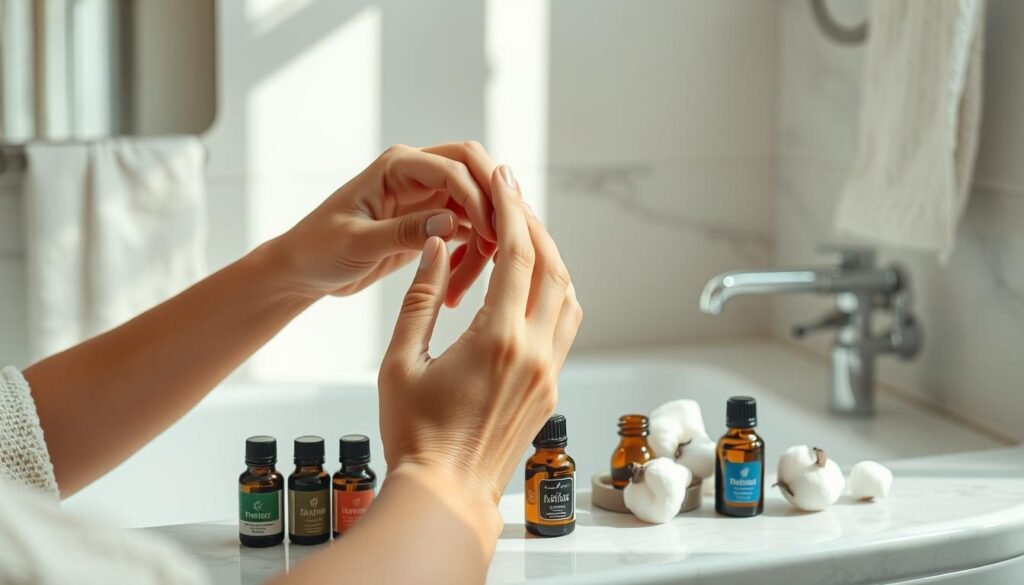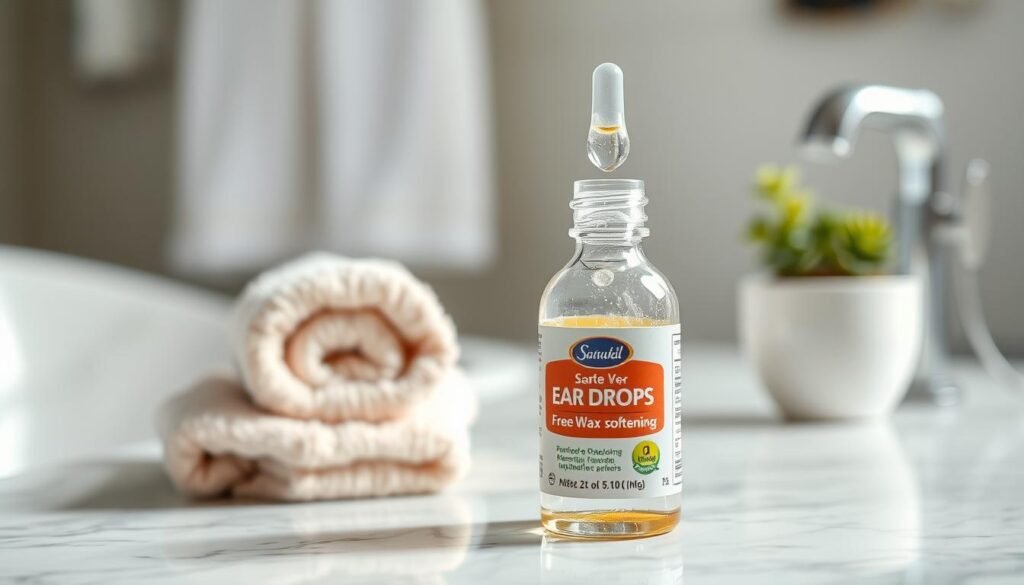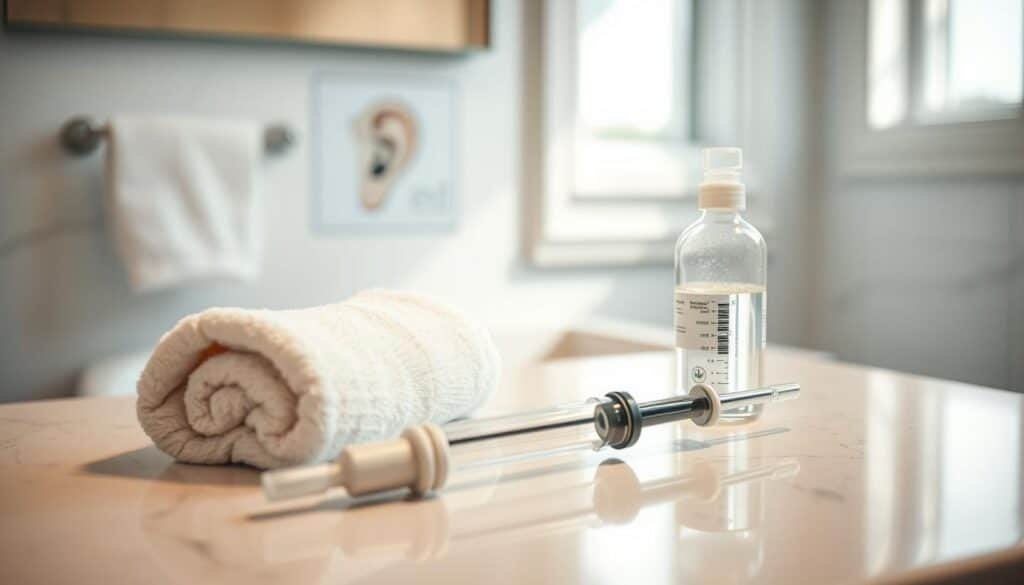Ever wondered if you could safely remove ear wax at home? I’ve dealt with ear wax buildup and found ways to keep my ears clean. In this guide, I’ll share my experiences and tips on how to massage ear wax out effectively.
Ear wax is a natural protector, but too much can cause problems. I’ll show you safe ear wax removal at home techniques. We’ll focus on gentle massage and other easy methods. We’ll also cover ear wax buildup prevention to keep your ears in top shape.
Key Takeaways
- Ear wax is beneficial but can cause issues if it builds up
- Massage is a gentle, effective method for ear wax removal
- Safe at-home techniques can help manage ear wax
- Proper ear care is crucial for preventing excessive buildup
- Know when to seek professional help for ear wax problems
Understanding Ear Wax: Function and Buildup
Ear wax is a natural protector for our ears. It’s interesting to think about why some people have more than others. Let’s dive into ear wax’s role, why it builds up, and its signs.
The Purpose of Ear Wax
Ear wax is key to keeping our ears healthy. It catches dust and debris, keeping our ears clean. It also keeps the ear canal moist and prevents itchiness. Plus, it fights off infections with its antibacterial properties.
Causes of Excessive Ear Wax
Too much ear wax can cause issues. Here are some reasons why:
- Narrow or hairy ear canals
- Frequent use of earbuds or hearing aids
- Genetics
- Age-related changes in wax consistency
Using cotton swabs can push wax deeper, making it worse.
Signs of Ear Wax Buildup
Knowing the signs of ear wax buildup is crucial. Look out for:
- Earache or a feeling of fullness in the ear
- Tinnitus (ringing in the ears)
- Partial hearing loss
- Dizziness
- Itching or drainage from the ear canal
If you notice these, see a healthcare professional for help.
The Importance of Safe Ear Wax Removal
Safe ear wax removal is key for ear health. I’ve found that wrong methods can cause big problems. For example, pushing wax deeper or damaging the eardrum are serious risks.
Many use cotton swabs or other objects to clean their ears. This is dangerous and can do more harm than good. It’s important to use gentle, approved methods for cleaning.
Getting professional help is usually the safest choice for ear wax removal. Doctors have the right tools and know-how to safely remove wax. They can also find and fix any issues that might be causing too much wax.
“Never insert anything smaller than your elbow into your ear.”
This saying is very true. The ear is a delicate part of our body, and we must be careful with it. Here’s a look at safe and unsafe ways to remove ear wax:
| Safe Methods | Unsafe Methods |
|---|---|
| Softening drops | Cotton swabs |
| Gentle irrigation | Ear candles |
| Professional removal | Hairpins or keys |
| Gentle massage | Aggressive digging |
By knowing the risks and picking safe methods, we can keep our ears healthy. Remember, if you’re unsure, always ask a healthcare professional.
How to Massage Ear Wax Out

Massaging your ears can help remove stubborn ear wax. This technique is good for minor blockages. Let’s look at how to do it safely and effectively.
Step-by-Step Massage Technique
First, get into a comfortable position. Use your pointer and middle fingers behind your earlobe. Gently press and move in slow circles.
Then, gently pull your earlobe while opening and closing your mouth. This helps loosen the wax. Tilt your head a bit to help the wax drain out.
Frequency and Duration of Massage
Limit ear massages to a few minutes per ear. Doing it once or twice a day is enough. Too much can irritate your ear or push the wax deeper.
Precautions When Massaging
Be gentle when massaging your ears. Never put anything into your ear canal. If it hurts, stop right away.
For ongoing problems, see a doctor. Remember, this method is not for serious blockages.
“The ear is a delicate organ. Always err on the side of caution when attempting any at-home ear care techniques.”
By following these steps, you can try to massage ear wax out at home. If problems don’t go away, see a healthcare professional for help.
Oil-Based Home Remedies for Ear Wax Removal
I’ve found several effective ear wax softening methods that use natural ingredients. These oil-based remedies can help with natural ear wax removal without harsh chemicals.
Olive oil is a popular choice for ear wax removal. I warm a few drops between my fingers and gently pour them into my ear canal. Tilting my head to the side, I let the oil work its magic for about 5 minutes. This process softens the wax, making it easier to come out on its own.
Almond oil and mineral oil are great alternatives. They work similarly to olive oil, breaking down stubborn ear wax. I’ve had success using these oils once or twice daily until the blockage clears up.
For preventive care, I apply this treatment once a week. After using any oil, I rinse my ear with warm water from the shower to remove any residue.
| Oil Type | Application Frequency | Duration |
|---|---|---|
| Olive Oil | 1-2 times daily | 5 minutes |
| Almond Oil | 1-2 times daily | 5 minutes |
| Mineral Oil | 1-2 times daily | 5 minutes |
Remember to always use oil at a comfortable temperature. Too hot or cold can cause discomfort or irritation. With consistent use, these natural ear wax removal techniques can keep your ears clear and healthy.
Over-the-Counter Ear Drops for Wax Softening

OTC ear wax removal products are a handy way to deal with too much ear wax. Ear drops for softening wax can be very effective if used right. We’ll look at the different kinds, how to use them, and any possible side effects.
Types of OTC Ear Drops
There are many ear drops for softening wax. They often have carbamide peroxide, mineral oil, glycerol, or hydrogen peroxide. Each one works in its own way to break down ear wax.
| Ingredient | Mechanism | Effectiveness |
|---|---|---|
| Carbamide Peroxide | Releases oxygen to soften wax | High |
| Mineral Oil | Lubricates and softens wax | Moderate |
| Glycerol | Moisturizes and softens wax | Moderate |
| Hydrogen Peroxide | Oxidizes and breaks down wax | High |
How to Use Ear Drops Safely
To safely use ear drops for wax softening, follow these steps:
- Tilt your head sideways
- Gently pull your outer ear up and back
- Apply the recommended number of drops
- Keep your head tilted for a few minutes
- Wipe away excess with a clean cloth
Always read and follow the instructions on the product. These ear wax removal products are usually safe for most people. But, they might not work for severe blockages or if your eardrum is perforated.
Potential Side Effects
Ear drops for wax softening are generally safe, but some people might have side effects. These can include feeling dizzy, ear irritation, or allergic reactions. If you have these problems or they get worse, see a doctor right away.
Irrigating Your Ears: Techniques and Tools

Ear irrigation is a safe and effective way to remove stubborn ear wax. Using the right tools can make a big difference. Let’s look at some popular methods you can try at home.
One easy method is using a soft bulb syringe. Fill it with lukewarm water, tilt your head, and gently squeeze. This will flush out your ear canal, removing excess wax.
If you want a more advanced method, consider professional tools. The Earigator, found at audiology centers, offers precise control. It’s designed for safe ear irrigation.
Comparison of Ear Irrigation Methods
| Method | Ease of Use | Effectiveness | Cost |
|---|---|---|---|
| Bulb Syringe | Easy | Moderate | Low |
| Earigator | Moderate | High | High |
| Shower Head Attachment | Easy | Low to Moderate | Low |
Remember, safety is key when using ear irrigation methods. Avoid these techniques if you have a perforated eardrum or recent ear surgery. With the right tools, you can keep your ears clean and healthy at home.
When to Seek Professional Help
It might be tempting to try to remove ear wax at home. But sometimes, you really need a professional. Let’s look at when you should get medical help and what services they offer.
Symptoms Requiring Medical Attention
If you notice any of these signs, it’s time to see a doctor:
- Severe hearing loss
- Persistent ear pain
- Dizziness or vertigo
- Discharge from the ear
- Ringing in the ears (tinnitus)
Professional Ear Wax Removal Methods
Doctors use special tools and methods for safe ear wax removal. Here are some common ones:
| Method | Description | Duration |
|---|---|---|
| Manual Removal | Uses a curette or cerumen spoon | 15-20 minutes |
| Irrigation | Controlled water pressure to flush out wax | 20-25 minutes |
| Suction | Gentle vacuum to extract wax | 15-30 minutes |
These services are quick, usually taking 15-30 minutes. They’re done under careful watch to make sure they’re safe and work well. If you keep having ear problems, don’t wait to get medical help from a skilled doctor.
Preventing Ear Wax Buildup
Keeping your ears clean is important for your health. I’ve found that simple habits can help a lot. It’s best to avoid pushing wax deeper and instead use gentle cleaning methods.
Using a few drops of mineral oil or olive oil in your ears once a week is helpful. It softens the wax, letting it come out naturally. After swimming or bathing, dry your ears well to avoid moisture buildup.
Don’t use cotton swabs to clean inside your ear canal. It can push wax deeper and cause issues. If you have too much wax, seeing an ENT specialist regularly is a good idea.
| Do’s for Ear Wax Prevention | Don’ts for Ear Wax Prevention |
|---|---|
| Use oil drops weekly | Insert cotton swabs in ear canal |
| Dry ears after water exposure | Use ear candles |
| Schedule regular ENT check-ups | Ignore persistent ear discomfort |
| Clean outer ear with soft cloth | Attempt self-removal of impacted wax |
By following these tips, I’ve kept my ears healthier and reduced wax problems. Remember, regular ear care is essential to avoid issues.
Conclusion
I’ve looked into safe ways to remove ear wax and keep ears healthy. There are many home methods, like gentle massage and drops, to manage ear wax. It’s important to be careful and only use approved methods for ear care.
Knowing when ear wax builds up too much is crucial. If you feel constant discomfort or have trouble hearing, see a doctor. They can help with tough wax problems.
Our ears are very sensitive. It’s important to clean them gently and avoid harsh DIY methods. By following these tips and watching for changes, you can keep your ears healthy and avoid wax issues.
FAQ
What is the purpose of ear wax?
What causes excessive ear wax buildup?
What are the risks of improper ear wax removal?
How do I massage ear wax out?
What oil-based remedies can help remove ear wax?
What types of over-the-counter ear drops are available for wax softening?
How does ear irrigation work for wax removal?
When should I seek professional help for ear wax removal?
How can I prevent ear wax buildup?
Source Links
- 5 TIPS FOR GOOD EAR WAX REMOVAL – https://www.lescentresmasliah.com/en/5-tips-for-good-ear-wax-removal/
- What to Do (and Not Do) If You Have an Ear Wax Blockage – https://www.verywellhealth.com/all-about-ear-wax-blockage-1192040
- Ear Wax: How to Keep It in Check and Massage Ear Wax Out – https://americanhearing.us/understanding-how-to-reduce-ear-wax/?srsltid=AfmBOoqMHiq8pha6Uzt2svfx3N1BlU2VzKq_12MHUlCa1j7V5A95609Y











